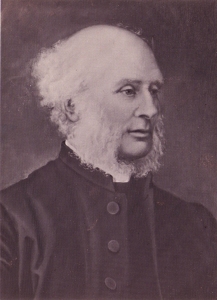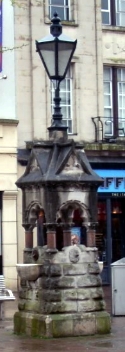
The picture to the left is of the Ven. Henry Fearon, Archdeacon of Leicester from 1863 until 1884, and Rector of All Saints', Loughborough, from 1848 until his death in 1885. He is remembered in Loughborough for his involvement in the introduction of the first fresh water supply to the town.
Who Lived at the Rectory?

Click on the 'timeline' or drag the LAHS logo along the line to reveal who was the resident Rector in the year shown.
Or click to see census data.
Or click to see census data.
1190
Rectory Timeline
1960
John Southam
Rector 1408 – 1416 and Canon of Lincoln
In preparation for his grand funeral, John Southam left 100 shillings to be spent on his burial and gave explicit instructions concerning it.
“A stone of marble large enough to cover my body with a portraiture and writing. There to be no hearse (i.e. a frame of candles) round my body, but 2 wax candles weighing 10lbs to be placed at the head and foot of the grave and lit during my funeral and to remain for 8 days following. They then to be placed in the great lattern candlesticks on either side of the High Altar and to be lit at the Elevation of the Host.
There to be 12 wax torches each costing 6s.8d burnt at my funeral and obit, to be carried by my poor servants, who were to be dressed in black cloaks and caps.
A loaf, a pennyworth of ale and a dish of meat to be given to each poor man seeking alms on the day of my funeral and to those imprisoned in Lincoln Castle or any other prison in Lincoln 5d in honour of the 5 wounds of Christ.”
Nicholas Hall
The 'Royalist' Rector 1642–1646 & 1661-1669
Ejected from his Rectory in 1646 by Parliamentarians he fled to Newcastle where he had inherited a baronetcy from his cousin, Sir Alexander Hall.
He successfully petitioned the House of Lords in 1661 for the securing of the revenues of his living and the right to be reinstated in his rectory in Loughborough. It was about this time that he married his second wife, Elizabeth, the 4th daughter of Thomas Farnham gent. of the Nether Hall, Quorn.
The Hall chair on display inside All Saints’ Church bears the initials E.H. and the date 1661 and is believed to have been a marriage gift to Nicholas Hall’s wife Elizabeth.
George Bright
Rector 1669-1696 and Dean of St. Asaph’s
In his will George Bright required his Trustees:
‘to buy houses or land in or near Loughborough to the value of £200 and settle the same for the use and benefit of a qualified person (i.e. the Rector) for ever to read dayly prayers in the morning in the Parish church of Loughborough, Sundays and 36 days in Harvest excepted.’
This money was forthwith laid out in the purchase of a piece of meadowland, of about 8 acres, lying between Loughborough and Cotes, now known as “ The Prayer Piece”.
The custom of saying the Daily Office in the church is perpetuated by the Rector of All Saints’ to this day.
Henry Fearon
Rector 1848 - 1885 and Archdeacon
During the early nineteenth century the population of Loughborough had grown more quickly than anywhere else in the county. Houses in the town were huddled together with no planning and drainage was non-existent. Of the 73 streets in the town 29 had open privies, cesspools and heaps of manure lying next to back doors.

Miasma (polluted air) was thought by many, including doctors, to be the source of infection. But then the new idea of a link between bacteria and disease began to point to the contamination of drinking water by sewage.
In 1848 Loughborough had suffered another serious outbreak of cholera. The mortality rate was 28 per 1000 inhabitants and the average age at death was 24 yrs.
A General Board of Health Inspector recommended in 1849 the provision of a pure water supply as an alternative to inadequate and polluted wells and the construction of a drainage system in the town. Plans were drawn up by a local Board of Health but were not put into action.
The Rector Henry Fearon who had studied sanitary science while at Cambridge led a campaign pointing out that using rate payers’ money to construct the drains would be cheaper than the heavy charges for those being made ill as a result of no drains. The first drainage system in Loughborough was finally completed in
Further campaigns including the formation of a private company to pipe water from the Black Brook led finally to the Board bringing fresh water to the town in 1870. Archdeacon Fearon erected a fountain in the market place where it still stands (picture right).
A booklet  titled "Henry Fearon" is available from the Museum. Please enquire.
titled "Henry Fearon" is available from the Museum. Please enquire.
 titled "Henry Fearon" is available from the Museum. Please enquire.
titled "Henry Fearon" is available from the Museum. Please enquire.